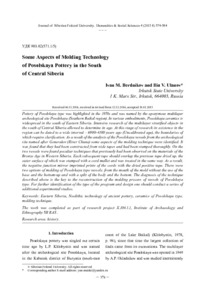Some Aspects of Molding Technology of Posolskaya Pottery in the South of Central Siberia
Скачать файл:
URI (для ссылок/цитирований):
https://elib.sfu-kras.ru/handle/2311/16759Автор:
Berdnikov, Ivan M.
Ulanov, Ilia V.
Бердников, И.М.
Уланов, И.В.
Дата:
2015-04Аннотация:
Pottery of posolskaya type was highlighted in the 1970s and was named by the eponymous multilayer
archeological site Posolskaya (Southern Baikal region). In various embodiments, posolskaya ceramics is
widespread in the south of Eastern Siberia. Intensive research of the multilayer stratified objects in
the south of Central Siberia allowed to determine its age. At this stage of research its existence in the
region can be dated to a wide interval – 6900-4100 years ago (Uncalibrated age), the boundaries of
which require clarification. As a result of the analysis of the posolskaya vessels from the archeological
site named after Generalov (River Chuna) some aspects of the molding technique were identified. It
was found that they had been constructed from wide tapes and had been stamped thoroughly. On
the two vessels were found peculiar techniques that previously had been observed on the materials
of the Bronze Age in Western Siberia. Each subsequent tape should overlap the previous tape dried
up, the outer surface of which was stamped with a cord mallet and was treated in the same way.
As a result, the negative junction mirror imprinted prints of the cords with the dried positive tape.
There were two options of molding of posolskaya type vessels: from the mouth of the mold without
the use of the base and the bottom-up and with a split of the body and the bottom. The diagnosis of
the technique described above is the key to the reconstruction of the molding process of vessels of
posolskaya type. For further identification of the type of the program and design one should conduct
a series of additional experimental studies Керамика посольского типа выделена в 1970-е гг. и получила наименование по эпонимной
многослойной стоянке Посольская (Южное Прибайкалье). В различных вариантах посольская
керамика широко распространена на юге Восточной Сибири. Интенсивные исследования
многослойных стратифицированных объектов юга Средней Сибири позволили уточнить ее
датировку. На данном этапе исследований время ее бытования в регионе можно датировать
широким интервалом – 6900–4100 л. н. (некалиброванный возраст), границы которого
требуют уточнения. В результате анализа посольских сосудов со стоянки им. Генералова
(р. Чуна) выявлены некоторые аспекты формовочной техники. Установлено, что они
конструировались из широких лент и тщательно выбивались. На двух сосудах зафиксированы
следы использования своеобразного технического приема, который до этого отмечался по
материалам бронзового века Западной Сибири. Каждая последующая лента накладывалась
внахлест на предыдущую подсохшую ленту, внешняя поверхность которой была выбита
шнуровой колотушкой, и обрабатывалась таким же образом. В результате на негативе спая
зеркально отпечатывались оттиски шнуров с подсохшей позитивной ленты. Предложено два
варианта формовки посольских сосудов: с устьевой части без использования формы-основы и
снизу вверх с раздельным конструированием тулова и дна. Диагностика охарактеризованного
выше технического приема является ключом к реконструкции процесса формования сосудов
посольского типа. Для идентификации вида программы и особенностей конструирования
следует дополнительно провести серию экспериментальных исследований

